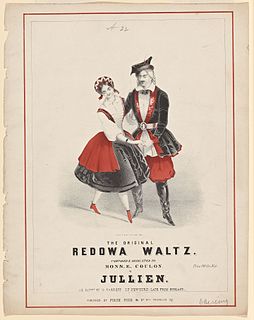Related Research Articles
In some types of partner dance, lead and follow are designations for the two dancers comprising a dance pairing. The Lead is responsible for guiding the couple and initiating transitions to different dance steps and, in improvised dances, for choosing the dance steps to perform. The Lead communicates choices to the Follow, and directs the Follow by means of subtle physical and visual signals, thereby allowing the pair to be smoothly coordinated.

A redowa is a dance of Czech origin with turning, leaping waltz steps that was most popular in Victorian era European ballrooms.
This is a list of dance terms that are not names of dances or types of dances. See List of dances and List of dance style categories for those.

In ballroom dancing, directions of progressive movement, in particular, directions of steps, can be indicated either in relation to the room or in relation to the body position. Directions of turns, although there are only two of them, may also be indicated in several ways.

Box step is a basic dance step named after the pattern it creates on the floor, which is that of a square or box. It is used in a number of American Style ballroom dances: rumba, waltz, bronze-level foxtrot. While it can be performed individually, it is usually done with a partner. This is the most common dance step in the waltz. In international standard dance competition, there is a similar step called closed change.
The closed change is a Pre-Bronze, or newcomer waltz figure, performed in closed position. Changes may start of the right foot or left foot, moving forward or backward. This makes four different types of closed changes. Combining two changes results in a box step. In right changes the man starts from the right foot, while in left ones the man starts from the left foot.
Samba de Gafieira is a partner dance to various Brazilian samba musical rhythms. Unlike street and club forms of Brazilian samba, it evolved as a ballroom dance.
The country/western two-step, often called the "Texas two-step" or simply the "two-step," is a country/western dance usually danced to country music in common time. "Traditional [Texas] two-step developed, my theory goes, because it is suited to fiddle and guitar music played two-four time with a firm beat [found in country music]. One-two, one-two, slide-shuffle."
The Texas two-step is the same step known to ballroom dancers as the international fox-trot. Except for the one-step, which is just that, most Texas dances are variations of a two-step, also called a half-step, which is simply a step-close-step. The Texas two-step is generally done with two long steps and a step-close-step to two-four time. Speeded up, it's a shuffle or double shuffle, but still a two-step.

The chassé is a dance step used in many dances in many variations. All variations are triple-step patterns of gliding character in a "step-together-step" pattern. The word came from ballet terminology.

Waltz is one of the five dances in the Standard category of the International Style ballroom dances. It was previously referred to as slow waltz or English waltz.
Contra body movement (CBM) is a term used in ballroom dances, such as Waltz, Foxtrot, Tango, Quickstep. It describes a specific coordination of the movement of a dancer's body when doing or preparing to do a step which involves rotation.
The promenade position is a dance position in ballroom and other dances. It is described differently in various dance categories.
A natural turn is a dance step in which the partners turn around each other clockwise. Its near-mirror counterpart is the reverse turn, which is turning to the counter-clockwise.
The natural spin turn is a ballroom dance step used in the waltz. It is typically used to advance a couple 7⁄8 of a turn down line of dance, although an underturned spin turn is also very useful for turning a corner. The natural spin turn is also considered an intermediary step toward learning pivots.
The impetus is a ballroom dance step used in the waltz, foxtrot or quickstep. The open impetus is one of several ways to get into promenade position and is used to turn dancers around corners or change their direction on the dance floor. It is often performed after a natural turn.
The Telemark is a ballroom dance step; in waltz competition, it is in the Silver syllabus. Telemarks are reverse turns where the follower does a heel turn as the leader travels around her. There are similar Telemarks in foxtrot and quickstep.
A wing is a ballroom dance move, in the silver syllabus of competition waltz. It is a transitional movement that repositions the follower to the leader's left side. Thus, while many dance moves can precede a wing, only a reverse movement can follow a wing, such as a reverse turn, double reverse spin, Telemark, fallaway reverse, or drag hesitation.
There are several types of lock step in waltz dancing, including International Standard waltz. A "lock step" is when the moving foot approaches to the standing foot and crosses in front of or behind it, creating a "check" position.
The chassé is a waltz ballroom dance figure. Like chassés in other dances, it involves a triple-step where one foot "chases" the other in a "step-together-step" pattern. It is derived from a ballet step.
References
- ↑ "Side whisks". BallroomDancers.com.
- ↑ "Whisk". BallroomDancers.com. Retrieved 2020-05-04.
- ↑ "Back whisk". DanceCentral.info. Retrieved 2020-06-01.
- ↑ "Left whisk". DanceCentral.info. Retrieved 2020-05-04.
- ↑ "Left whisk". BallroomDancers.com. Retrieved 2020-05-04.